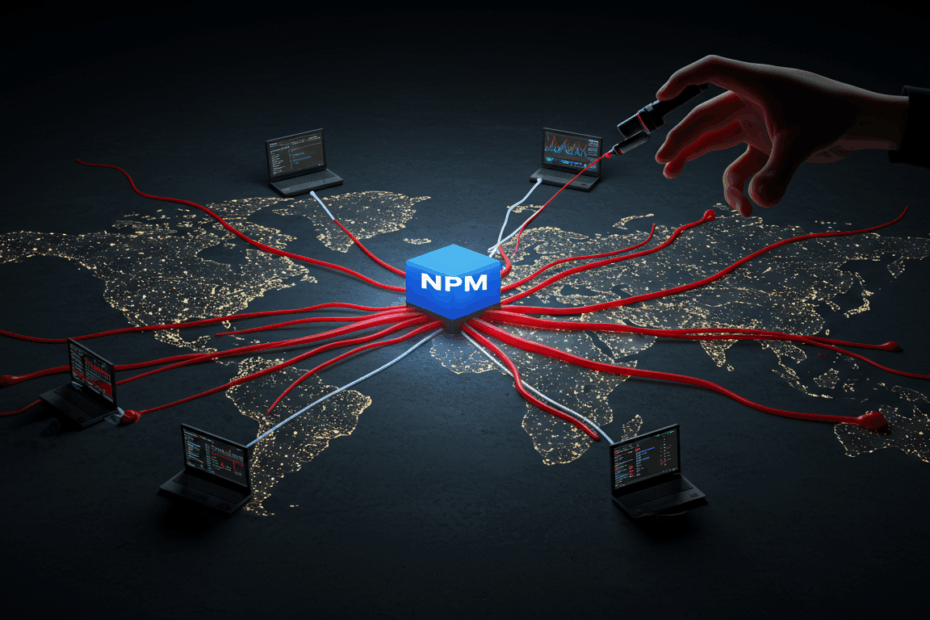The Unseen Threat: Navigating the Treacherous Waters of NPM Supply Chain Attacks
John: In the world of software development, we often talk about building on the shoulders of giants. We use pre-written code to build bigger and better things faster. But lately, it feels like some of those giants have had their pockets picked. We’re seeing a dramatic escalation in what we call software supply chain attacks, specifically targeting the NPM ecosystem, and the fallout is affecting millions of developers and a countless number of companies.
Lila: That sounds pretty serious, John. For our readers who might be new to this, could you break down what a “supply chain attack” actually is in this context? When I hear “supply chain,” I think of trucks and shipping containers, not code.
John: That’s an excellent analogy to start with. In manufacturing, a supply chain is every step that gets a product from raw material to the consumer. If you poison the source of the raw material—say, the water used to make a soft drink—you compromise every single bottle produced from it. A software supply chain attack is the digital equivalent. Instead of attacking a thousand different companies, a threat actor attacks one, single, widely-used component—a piece of code we call a “package”—and in doing so, they infect every application that uses it. It’s insidious because you’re being attacked by a component you thought you could trust.
Lila: So it’s like a Trojan horse, but instead of hiding inside a gift, it’s hiding inside a legitimate tool that developers are actively choosing to use? That’s terrifying.

Understanding the Battleground: What is NPM?
John: Precisely. And the primary battleground for these attacks in the JavaScript world is NPM. NPM stands for Node Package Manager. Think of it as a gigantic, public library or an app store for developers. It hosts over two million of these free, reusable code packages. If a developer needs to perform a common task, like formatting a date or testing if a variable is a number, they don’t write it from scratch. They just run a simple command, `npm install`, and pull in a package that does it for them.
Lila: And that’s what makes modern web development so fast, right? Because you’re not reinventing the wheel every time. But why is NPM such a popular target? Is it less secure than other systems?
John: It’s less about it being inherently insecure and more about its sheer scale and the interconnected nature of its packages. It’s the largest software registry in the world. A single project can have hundreds, even thousands, of dependencies. A dependency is simply a package that another package needs to work. This creates a massive, sprawling tree of code. Your project might only directly use ten packages, but those ten packages might each depend on ten others, and so on. Attackers know this. If they can compromise one tiny, seemingly insignificant package that is a dependency-of-a-dependency for a popular tool, they can achieve massive distribution for their malware.
Lila: It’s a ripple effect. A tiny pebble of malware tossed into the pond can create a tidal wave across the entire ecosystem. I think I’m starting to see the scale of the problem.
The Anatomy of an Attack: How Malware Gets In
John: Exactly. And the methods attackers use are becoming increasingly sophisticated. They’ve developed a whole playbook for getting their malicious code into the supply chain.
Lila: Can you walk us through some of those methods? How does a trusted package suddenly become a vehicle for malware?
John: Certainly. There are several common vectors.
- Typosquatting: This is the simplest method. Attackers publish a package with a name very similar to a popular one, like `request` vs. `requesst`. A developer makes a typo, installs the malicious version, and the trap is sprung.
- Dependency Confusion: This is a cleverer trick. An attacker looks at a company’s internal code, finds the name of a private package they use, and then publishes a malicious package with the same name to the public NPM registry. If the build system isn’t configured perfectly, it might accidentally download the public, malicious version instead of the private, internal one.
- Account Takeover (ATO): This is the most damaging and, unfortunately, the one we’re seeing most often in recent, high-profile attacks. Attackers use phishing techniques (tricking people with fake emails or websites) to steal the login credentials of a legitimate package maintainer—the person who has permission to update the code. Once they have access, they can publish a new version of the trusted package with their malware baked right in.
Lila: That last one seems to be the core of the recent incidents we’ve been reading about, like the ones involving `eslint-config-prettier` and the `is` package. The attackers didn’t create a new fake package; they hijacked a real, popular one.
John: Correct. The `is` package, for example, is a fundamental utility downloaded nearly 3 million times a week. Attackers compromised the maintainer’s account and pushed malicious updates. For hours, anyone running a standard `npm install` or `npm update` command on a project that depended on this package was unknowingly installing a backdoor on their system. The malware used in these recent attacks was a multi-stage loader; the initially installed code was small and just fetched a more powerful, secondary piece of malware from a remote server, making it harder to detect at first glance.
Lila: So the very commands developers use every day to keep their projects up-to-date became the weapons used against them. That really flips the concept of security on its head.
The Human Element: Maintainers and the Community
John: It does, and it highlights a critical, often-overlooked aspect of open-source software: the human element. The entire ecosystem is built on the hard work of thousands of maintainers, many of whom are volunteers. They build and support these essential tools in their free time, out of passion. They aren’t massive corporations with dedicated security teams; they’re individuals.
Lila: So when we hear about a package being compromised, it’s often not a company that was hacked, but a single person who might have fallen victim to a phishing email? That adds a whole new layer of sympathy. Who is actually responsible for policing all of this?
John: It’s a shared responsibility, which is part of the challenge.
- The Maintainers: They are the first line of defense. They are strongly encouraged to use security best practices, like two-factor authentication (2FA), which makes account takeovers much harder.
- NPM/GitHub: Since Microsoft acquired GitHub, which in turn owns NPM, they have invested heavily in security. They have automated scanning that looks for malware in new package versions, and a dedicated security team that responds to incident reports. When a malicious package is identified, they remove it and publish security advisories.
- The Community: Security researchers and even regular developers are crucial. They are often the ones who spot suspicious code, investigate it, and report it to NPM, triggering the takedown process. The community is a massive, decentralized immune system.
Lila: It sounds like a constant cat-and-mouse game. And it seems the “mouse”—the attacker—only needs to get lucky once, while the “cats” have to be vigilant all the time.

Attacker Motives and the Future of the Threat
John: An apt summary. The motivations for these attacks are what you’d typically expect from cybercrime. The malware we’ve seen deployed in these NPM attacks is often designed to steal information. It scours the compromised developer’s machine for sensitive files: cryptocurrency wallet keys, cloud service credentials (like AWS or Azure keys), private SSH keys, browser cookies, and saved passwords. For an attacker, a developer’s computer is a treasure trove.
Lila: Because a developer’s credentials could grant access to a company’s entire infrastructure. So, the initial infection of a developer’s laptop is just the first step in a much larger heist. What does the future of this look like? Will it just get worse?
John: The trend lines suggest an increase in both frequency and sophistication. As our defenses get better, attackers adapt. We’re on the cusp of seeing AI play a much larger role on both sides of this conflict. Attackers could use AI to generate more convincing phishing emails or to create polymorphic malware (malware that changes its own code to avoid detection). They could even use AI to automatically search for and identify high-value, poorly-maintained packages to target.
Lila: That’s a grim outlook. But can’t we use AI for defense as well? It seems like a perfect task for a machine—sifting through millions of lines of code to find anomalies.
John: Absolutely. And that’s already happening. Security companies are building AI-powered tools that analyze package behavior. Instead of just looking at the code itself (static analysis), they run the package in a safe, isolated environment (a sandbox) and watch what it does. Does it try to access the network? Does it read files it shouldn’t? AI models can learn the patterns of normal package behavior and flag deviations that might signal a threat, often much faster than a human could. The future of supply chain security will be a race between malicious AI and defensive AI.
Is This Just an NPM Problem?
Lila: We’ve focused a lot on NPM and JavaScript. Are developers in other languages, like Python or Java, safe from this?
John: Not at all. The principles are universal. Every major programming language has its own package repository, and every single one is a target. Python has PyPI (the Python Package Index), Java has Maven Central, Ruby has RubyGems, and so on. They have all faced similar issues with typosquatting, dependency confusion, and malware injection. The fundamental problem is the model of trust in public, open-source code. NPM gets a lot of headlines because of the sheer size of the JavaScript ecosystem and its central role in web development, front-end and back-end, but the threat is ecosystem-agnostic.
Lila: So the lessons we’re learning from the attacks on NPM are applicable to any developer, regardless of their preferred tech stack.
Risks & Cautions: How to Protect Yourself
John: Precisely. The good news is that while you can’t eliminate the risk entirely, you can significantly mitigate it. There are concrete steps that individual developers and organizations can take to harden their defenses.
Lila: This is the part everyone’s been waiting for. What’s the action plan? What should a developer or a company do, starting today?
John: It’s about creating layers of security.
- Lock Your Dependencies: Use lockfiles. Files like `package-lock.json` (for NPM) or `yarn.lock` record the exact version of every package you’re using. This prevents unexpected updates from automatically pulling in a newly compromised version. You should only update dependencies deliberately.
- Audit and Vet: Don’t just blindly install packages. Before adding a new dependency, do some research. Is it well-maintained? Does it have a lot of users? Are there many open issues on its GitHub page? For critical infrastructure, you need a vetting process.
- Use Security Tooling: Integrate automated security scanning into your workflow. Tools like `npm audit`, Snyk, Socket, or GitHub’s Dependabot can scan your projects for packages with known vulnerabilities or malicious code and alert you.
- Practice the Principle of Least Privilege: The scripts and tools in your development pipeline should only have the permissions they absolutely need to do their jobs. Don’t run things as an administrator if you don’t have to. This can limit the damage a malicious package can do.
- For Maintainers: Enable 2FA: If you maintain any public package, no matter how small, enable Two-Factor Authentication on your NPM and GitHub accounts. This is the single most effective defense against the account takeovers we’ve seen recently.
Lila: That’s a great, actionable checklist. It seems like a shift from a “trust by default” mindset to a more cautious, “trust but verify” approach is necessary.
Expert Analysis on the Latest Attacks
John: It is. And security firms are unanimous in their analysis of the recent wave of attacks. Reports from CrowdStrike, Snyk, and BleepingComputer all point to a large-scale, coordinated phishing campaign targeting the personal accounts of developers. They aren’t brute-forcing their way in; they are tricking their way in. The attackers are sophisticated, patient, and they understand that developers are human and can make mistakes.
Lila: So the security perimeter is no longer just the corporate network; it’s the personal email inbox and security habits of every developer working on the code.
John: That’s the modern reality. The experts at firms like Endor Labs and Socket.dev have also highlighted the speed of these attacks. In the case of the `eslint-config-prettier` compromise, malicious versions were being downloaded by developers for hours before the threat was neutralized. This narrow window is why automated detection is so critical; human response times can sometimes be too slow to prevent widespread damage.
Breaking News: The `is` and `eslint` Compromises
Lila: Can we talk more specifically about those recent events? They seem to be the catalyst for this whole conversation. What exactly happened with the `is` package?
John: Certainly. The `is` package is a collection of simple type-checking utilities. As we mentioned, it’s incredibly popular due to its simplicity and usefulness. On July 19th, attackers who had gained access to the maintainer’s account published two new versions, `3.3.1` and `5.0.0`, containing malware. The malicious code was an obfuscated script (intentionally made hard to read) that would download and execute a second-stage payload from a remote server, effectively giving the attackers a backdoor into any machine that installed or updated to these versions.
Lila: And this went on for six hours, you said? How many people were affected?
John: It’s impossible to know the exact number, but given its millions of weekly downloads, the potential exposure was massive. The same pattern was seen with `eslint-config-prettier`, another hugely popular tool used to ensure consistent code formatting. In that case, several malicious versions were published, targeting developers. This wasn’t an isolated incident; it was part of a campaign that also compromised packages belonging to the Toptal organization after their GitHub account was breached. It’s a clear demonstration of an expanding, ongoing threat.
Lila: So, what’s the status now? Is it safe to use these packages?
John: Yes. In all these cases, once the threat was identified, the NPM security team acted quickly. They removed the malicious versions from the registry and the package maintainers published new, clean versions. Security advisories, like CVE-2025-54313 for the `eslint-config-prettier` issue, were issued. However, the key takeaway is that anyone who downloaded the compromised versions during that window needs to assume their system was breached and take immediate remediation steps. And the phishing campaign targeting maintainers is likely still active.

Frequently Asked Questions (FAQ)
Lila: This has been incredibly insightful, John. I think it would be helpful to wrap up with a quick FAQ section to summarize the key points for our readers. I’ll ask the questions.
John: An excellent idea. Fire away.
Lila: First up: In one sentence, what is a software supply chain attack?
John: It is a cyberattack that targets a trusted, third-party software component to distribute malware to all the downstream users of that component.
Lila: Why is NPM such a common target?
John: Because it is the world’s largest software registry, and its highly interconnected dependency graph allows a single compromised package to have a massive ripple effect across the entire software industry.
Lila: How can I check if I’ve been affected by a specific attack like the `is` package compromise?
John: Check your `package-lock.json` file to see which specific version of the package you have installed. If it matches one of the known malicious versions listed in the security advisories, you should assume you are compromised and begin incident response procedures immediately.
Lila: Does this mean open-source software is inherently insecure?
John: No, not at all. The transparency of open-source is actually a security strength, as it means anyone can inspect the code for flaws. However, it operates on a model of trust that can be exploited, which is why a “trust but verify” approach with modern security tooling is now essential.
Lila: And finally, what is the role of AI in all of this?
John: AI is a dual-use technology in this domain; it can be used by attackers to create more sophisticated threats, but it is also one of our most powerful new defenses, capable of analyzing code and behavior at a scale no human team can match.
Related Links and Further Reading
John: This is a rapidly evolving space, and staying informed is key. I recommend developers keep an eye on these resources:
- GitHub Advisory Database
- NPM Public Advisories
- The Snyk Blog (Security Research)
- The Socket.dev Blog (Supply Chain Security)
Lila: Thanks, John. It’s clear that in today’s development landscape, security isn’t just someone else’s job. It’s a shared responsibility, from the individual developer all the way up to the platform providers.
John: That’s the bottom line. The convenience of open-source is immense, but it comes with the responsibility to be vigilant. Stay informed, secure your accounts, and scan your code. It’s the only way to navigate these waters safely.
Disclaimer: The information in this article is for informational purposes only. It is not intended as security advice. Always conduct your own research and consult with a qualified cybersecurity professional for your specific needs.
